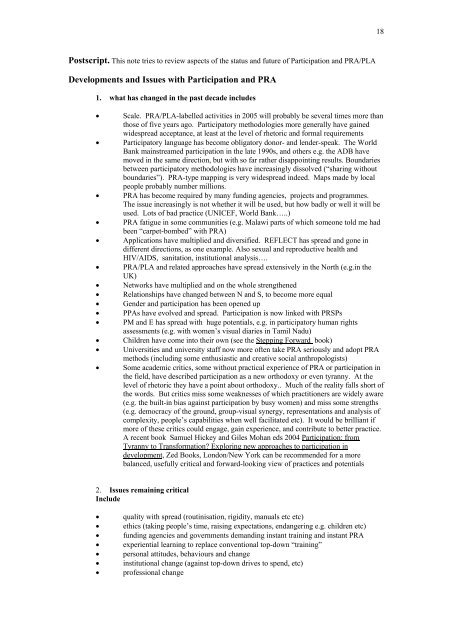R Chambers - Notes for participants in PRA-PLA course.pdf - PACA
R Chambers - Notes for participants in PRA-PLA course.pdf - PACA
R Chambers - Notes for participants in PRA-PLA course.pdf - PACA
You also want an ePaper? Increase the reach of your titles
YUMPU automatically turns print PDFs into web optimized ePapers that Google loves.
18<br />
Postscript. This note tries to review aspects of the status and future of Participation and <strong>PRA</strong>/<strong>PLA</strong><br />
Developments and Issues with Participation and <strong>PRA</strong><br />
1. what has changed <strong>in</strong> the past decade <strong>in</strong>cludes<br />
• Scale. <strong>PRA</strong>/<strong>PLA</strong>-labelled activities <strong>in</strong> 2005 will probably be several times more than<br />
those of five years ago. Participatory methodologies more generally have ga<strong>in</strong>ed<br />
widespread acceptance, at least at the level of rhetoric and <strong>for</strong>mal requirements<br />
• Participatory language has become obligatory donor- and lender-speak. The World<br />
Bank ma<strong>in</strong>streamed participation <strong>in</strong> the late 1990s, and others e.g. the ADB have<br />
moved <strong>in</strong> the same direction, but with so far rather disappo<strong>in</strong>t<strong>in</strong>g results. Boundaries<br />
between participatory methodologies have <strong>in</strong>creas<strong>in</strong>gly dissolved (“shar<strong>in</strong>g without<br />
boundaries”). <strong>PRA</strong>-type mapp<strong>in</strong>g is very widespread <strong>in</strong>deed. Maps made by local<br />
people probably number millions.<br />
• <strong>PRA</strong> has become required by many fund<strong>in</strong>g agencies, projects and programmes.<br />
The issue <strong>in</strong>creas<strong>in</strong>gly is not whether it will be used, but how badly or well it will be<br />
used. Lots of bad practice (UNICEF, World Bank…..)<br />
• <strong>PRA</strong> fatigue <strong>in</strong> some communities (e.g. Malawi parts of which someone told me had<br />
been “carpet-bombed” with <strong>PRA</strong>)<br />
• Applications have multiplied and diversified. REFLECT has spread and gone <strong>in</strong><br />
different directions, as one example. Also sexual and reproductive health and<br />
HIV/AIDS, sanitation, <strong>in</strong>stitutional analysis….<br />
• <strong>PRA</strong>/<strong>PLA</strong> and related approaches have spread extensively <strong>in</strong> the North (e.g.<strong>in</strong> the<br />
UK)<br />
• Networks have multiplied and on the whole strengthened<br />
• Relationships have changed between N and S, to become more equal<br />
• Gender and participation has been opened up<br />
• PPAs have evolved and spread. Participation is now l<strong>in</strong>ked with PRSPs<br />
• PM and E has spread with huge potentials, e.g. <strong>in</strong> participatory human rights<br />
assessments (e.g. with women’s visual diaries <strong>in</strong> Tamil Nadu)<br />
• Children have come <strong>in</strong>to their own (see the Stepp<strong>in</strong>g Forward book)<br />
• Universities and university staff now more often take <strong>PRA</strong> seriously and adopt <strong>PRA</strong><br />
methods (<strong>in</strong>clud<strong>in</strong>g some enthusiastic and creative social anthropologists)<br />
• Some academic critics, some without practical experience of <strong>PRA</strong> or participation <strong>in</strong><br />
the field, have described participation as a new orthodoxy or even tyranny. At the<br />
level of rhetoric they have a po<strong>in</strong>t about orthodoxy.. Much of the reality falls short of<br />
the words. But critics miss some weaknesses of which practitioners are widely aware<br />
(e.g. the built-<strong>in</strong> bias aga<strong>in</strong>st participation by busy women) and miss some strengths<br />
(e.g. democracy of the ground, group-visual synergy, representations and analysis of<br />
complexity, people’s capabilities when well facilitated etc). It would be brilliant if<br />
more of these critics could engage, ga<strong>in</strong> experience, and contribute to better practice.<br />
A recent book Samuel Hickey and Giles Mohan eds 2004 Participation: from<br />
Tyranny to Trans<strong>for</strong>mation? Explor<strong>in</strong>g new approaches to participation <strong>in</strong><br />
development, Zed Books, London/New York can be recommended <strong>for</strong> a more<br />
balanced, usefully critical and <strong>for</strong>ward-look<strong>in</strong>g view of practices and potentials<br />
2. Issues rema<strong>in</strong><strong>in</strong>g critical<br />
Include<br />
• quality with spread (rout<strong>in</strong>isation, rigidity, manuals etc etc)<br />
• ethics (tak<strong>in</strong>g people’s time, rais<strong>in</strong>g expectations, endanger<strong>in</strong>g e.g. children etc)<br />
• fund<strong>in</strong>g agencies and governments demand<strong>in</strong>g <strong>in</strong>stant tra<strong>in</strong><strong>in</strong>g and <strong>in</strong>stant <strong>PRA</strong><br />
• experiential learn<strong>in</strong>g to replace conventional top-down “tra<strong>in</strong><strong>in</strong>g”<br />
• personal attitudes, behaviours and change<br />
• <strong>in</strong>stitutional change (aga<strong>in</strong>st top-down drives to spend, etc)<br />
• professional change














